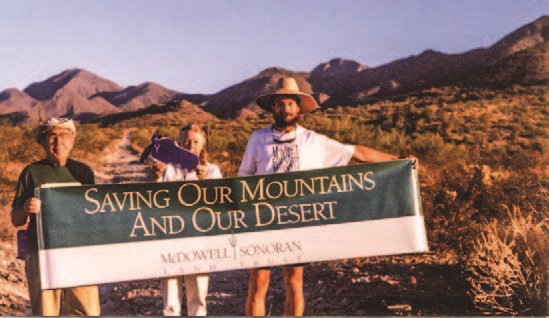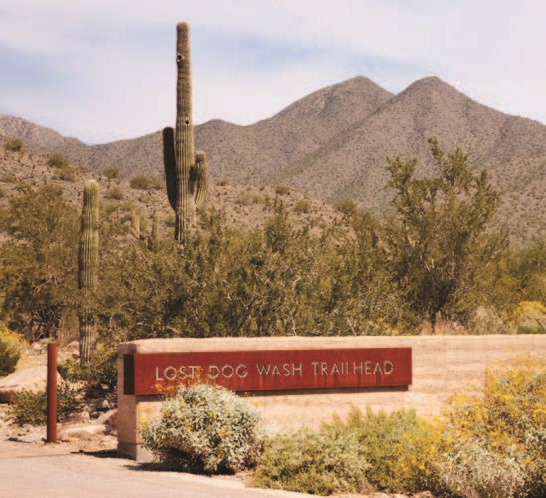Just five short years ago, we celebrated the McDowell Sonoran Conservancy’s 25th Birthday. As a part of that celebration, we remembered some of the most significant things that happened in each of our first 25 years.
We are now approaching our 30th Birthday, and we are taking this opportunity to reflect again on our past achievements, important moments, and dear memories that rise to the surface amongst hundreds, if not thousands, of individual moments for individual people.
With reflection, gratitude inevitably comes, and we are truly grateful for nearly 30 years with each of you.
Originally published in the 25th Anniversary Edition (Spring 2016) of Mountain Lines, our quarterly magazine of the McDowell Sonoran Conservancy.
1996: The Vision Becomes Reality
Chet Andrews, who would come to be affectionately known as McDowell Sonoran Conservancy “Steward #1”, had been working tirelessly as a preservationist since the 1980s as a member of the Arizona Mountaineer Club. As an avid hiker in the McDowell Mountains, he saw development beginning to creep into his beloved mountains and vowed to do some-thing about it. Andrews, one of the founding members of the McDowell Sonoran Land Trust, began researching land issues surrounding the McDowell Mountains. As he learned about the land ownership, he worried about the fact that “the whole area is owned by a variety of entities with varying degrees of control and protection.” But Andrews’ vision of a city-owned Preserve came to reality with the passage of Proposition 400 in 1995 when voters approved the City to collect funds to buy land in the Preserve with a tax equal to only one additional penny for every five dollars spent in the city.
Andrews then set in motion his next big idea – creating trails inside the Preserve. He created a volunteer stewardship group to build and maintain them. He believed that the citizens of Scottsdale, who agreed to buy the land, deserved the opportunity to explore and enjoy their Preserve.
In 1996, the first trail building and maintenance program began. It used a group of volunteers dedicated to protect and maintain Preserve land to do the work. With fortuitous foresight, the City of Scottsdale had formed an entirely new Preserve Division to reflect City Council priorities and carry out agreed-upon goals and objectives. The new Preserve Director Bob Cafarella was also a preservation advocate and lifelong hiker. Working together with other Scottsdale staff, Andrews and Cafarella recruited nearly 90 volunteers to build a trail for the first outdoor race held inside the Preserve. These volun-teers successfully cleared a five-mile desert trail that debuted at the Cactus Cup bike race held March 16-17. It attracted 2,600 mountain bikers and 40,000 spectators.
Afterwards, the trail opened for all hikers, equestrians and recreational mountain bikers. That original trail began at West-World, turned south along a dirt road toward the old Verde Canal, crossed east into the McDowell Mountain Ranch com-munity, continued up to Taliesin and then looped back west. Today, parts of the original Cactus Cup trail are integrated into the WestWorld and Taliesin trails.
1997: Land Trust Advocacy Advances
While land acquisitions by the City continued through the late 1990’s, the Land Trust expanded its Preserve advocacy. Stewardship and education programs increased in number and frequency. To manage its growing administrative tasks and responsibilities, the Trust hired Sandy Bahr in 1997 as its first full-time director. When Bahr left the Trust to take a position on the staff of the Sierra Club, Carla became the Trust’s executive director, a position she held until 2007.
As a result of incorporating concepts developed by more than 1500 residents and business leaders in CityShape 2020, six guiding principles for land use and planning were adopted: preserve meaningful open space, enhance neighborhoods, advance transportation, seek sustainability, support economic vitality, and value Scottsdale’s unique lifestyle and character.
Responding to requests from the Scottsdale Historical Society and many residents, the City Council established the Scottsdale Historic Preservation Commission. To the delight of Scottsdale citizens, this led to passage of the city’s first archeological ordinance with many sites designated for protection located inside the Preserve.
Advocacy and conservation work continued throughout the year. Land trust work on the Preserve and strong com-munity support resulted in Mayor Sam Campana’s October 7 dedication of the first public trail in the McDowell Sonoran Preserve, the Lost Dog Wash Trail. Following the ceremony, the McDowell Sonoran Land Trust conducted its 100th hike into the Preserve along the new trail.
1998: A Volunteer Steward Program Launches
Partnering with Scottsdale Community College, the Land Trust began training volunteers called Preserve stewards. Dur-ing Fall Semester 1998, the College offered its first Preserve stewardship class, “How to Exercise Your Love of the Land”. Land Trust Administrator Carla and MLST Board Member Chet Andrews developed, designed and implemented the initial course. Andrews then became the long-time head of the Land Trust steward program.
The Land Trust’s Mountain Lines magazine described the new course as “preparing volunteers to work on the Preserve, training them in observing changing conditions in the Preserve, reporting violations, removing trash, chatting with visitors, and keeping track of safety and maintenance needs”. Experts were brought in to discuss flora and fauna, archaeology and geology, first aid, fire prevention, community preservation efforts, and stewardship procedures. The newly trained stewards would, in conjunction with the City, become caretakers of the Preserve. The first steward class included Art Agosta, Chet Andrews, Carla, Joan Clark, Jon Coffey, Nancy Dallett, Virginia Dotson, Jim Engstrom, Mary Flick, Janie Gomez-Terry, Lee Johnson, Richard Kautz, Bev Kinsey, Roy Kinsey, Carl Koch, Dick Rosler, Darcey Thomas and Tom Walsh.
The newly trained stewards helped to fulfill the City’s promise to give residents and visitors greater access to the Pre-serve by expanding the Land Trust’s hiking program to include mountain biking and equestrian trails. In addition, Land Trust trail builders began to work with the City to plan and build new trails as land was acquired.





